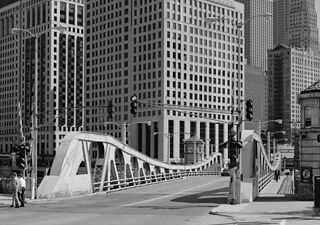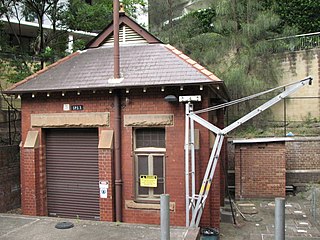Related Research Articles

A superstructure is an upward extension of an existing structure above a baseline. This term is applied to various kinds of physical structures such as buildings, bridges, or ships having the degree of freedom zero.

A pedestal or plinth is the support of a statue or a vase, and of a column in architecture. Smaller pedestals, especially if round in shape, may be called socles. In civil engineering, it is also called basement. The minimum height of the plinth is usually kept as 45 cm(for buildings). It transmits loads from superstructure to the substructure and acts as the retaining wall for the filling inside the plinth or raised floor.
The National Bridge Inventory (NBI) is a database, compiled by the Federal Highway Administration, with information on all bridges and tunnels in the United States that have roads passing above or below. This is similar to the grade crossing identifier number database compiled by the Federal Railroad Administration which identifies all railroad crossings. This bridge information includes the design of the bridge and the dimensions of the usable portion. The data is often used to analyze bridges and judge their conditions. The inventory is developed with the purpose of having a unified database for bridges to ensure the safety of the traveling public as required by the Federal-Aid Highway Act of 1968. It includes identification information, bridge types and specifications, operational conditions, bridge data including geometric data and functional description, and inspection data. Any bridge more than 20 feet long used for vehicular traffic is included.

An abutment is the substructure at the ends of a bridge span or dam supporting its superstructure. Single-span bridges have abutments at each end which provide vertical and lateral support for the span, as well as acting as retaining walls to resist lateral movement of the earthen fill of the bridge approach. Multi-span bridges require piers to support ends of spans unsupported by abutments. Dam abutments are generally the sides of a valley or gorge, but may be artificial in order to support arch dams such as Kurobe Dam in Japan.
In mathematical logic, an (induced) substructure or (induced) subalgebra is a structure whose domain is a subset of that of a bigger structure, and whose functions and relations are restricted to the substructure's domain. Some examples of subalgebras are subgroups, submonoids, subrings, subfields, subalgebras of algebras over a field, or induced subgraphs. Shifting the point of view, the larger structure is called an extension or a superstructure of its substructure.

Earthquake engineering is an interdisciplinary branch of engineering that designs and analyzes structures, such as buildings and bridges, with earthquakes in mind. Its overall goal is to make such structures more resistant to earthquakes. An earthquake engineer aims to construct structures that will not be damaged in minor shaking and will avoid serious damage or collapse in a major earthquake. Earthquake engineering is the scientific field concerned with protecting society, the natural environment, and the man-made environment from earthquakes by limiting the seismic risk to socio-economically acceptable levels. Traditionally, it has been narrowly defined as the study of the behavior of structures and geo-structures subject to seismic loading; it is considered as a subset of structural engineering, geotechnical engineering, mechanical engineering, chemical engineering, applied physics, etc. However, the tremendous costs experienced in recent earthquakes have led to an expansion of its scope to encompass disciplines from the wider field of civil engineering, mechanical engineering, nuclear engineering, and from the social sciences, especially sociology, political science, economics, and finance.

A girder bridge is a bridge that uses girders as the means of supporting its deck. The two most common types of modern steel girder bridges are plate and box.

The Franklin–Orleans Street Bridge, commonly known as the Franklin Street Bridge, is a bascule bridge over the Chicago River, in Chicago, Illinois, United States. It was built in October 1920, and is located directly southwest of the Merchandise Mart. Connecting the Near North Side with "The Loop," is at the junction of the branches of the river, lying directly west of the Wells Street Bridge. It carries four lanes of traffic in the northbound direction, and sidewalks are available on both sides of the bridge.
In model theory, a branch of mathematical logic, the notion of an existentially closed model of a theory generalizes the notions of algebraically closed fields, real closed fields, existentially closed groups, and dense linear orders without endpoints.

The Willimansett Bridge is a steel truss bridge over the Connecticut River located between Chicopee, Massachusetts and Holyoke, Massachusetts. It carries Massachusetts state routes 116 and 141.

In earthquake engineering, vibration control is a set of technical means aimed to mitigate seismic impacts in building and non-building structures.
In solid state physics, a superstructure is some additional structure that is superimposed on a given crystalline structure. A typical and important example is ferromagnetic ordering.

In Marxist theory, society consists of two parts: the base and superstructure. The base comprises the forces and relations of production into which people enter to produce the necessities and amenities of life. The base determines society's other relationships and ideas to comprise its superstructure, including its culture, institutions, political power structures, roles, rituals, and state. While the relation of the two parts is not strictly unidirectional, as the superstructure often affects the base, the influence of the base is predominant. Marx and Engels warned against such economic determinism.
West 65 is a residential complex in New Belgrade. It is at the corner of Omladinskih Brigada Street and the inner city ring road. The location features well-developed traffic infrastructure and public transportation network, allowing quick and convenient access to any other part of the city. The immediate vicinity has shopping, offices and service centres. It is about 15 minutes to the city centre. It includes 11 6 storey residential buildings, a mall and a 155 meter tower in Blok 65 of New Belgrade. It will be the tallest building in Belgrade until 2021.

A Rigid-frame bridge is a bridge in which the superstructure and substructure are rigidly connected to act as a continuous unit. Typically, the structure is cast monolithically, making the structure continuous from deck to foundation. The connections between members are rigid connections which transfer bending moment, axial forces, and shear forces. A bridge design consisting of a rigid frame can provide significant structural benefits, but can also be difficult to design and/or construct.

The Eugenio Lopez Junior Communications Center is the corporate headquarters of the ABS-CBN Corporation and its subsidiaries. The center occupies ten thousand (10,000) square meters of land area adjacent to the ABS-CBN Broadcasting Center and it includes two office buildings, a soundstage, three-level basement parking areas, a roof deck helipad, a film archives, a studio gallery, an exclusive executive dining restaurant, a garden, and the ABS-CBN Lingkod Kapamilya Foundation building. The center has a gross floor area of 101,608.32 square meters; almost seventy thousand (70,000) square meters of office space and over thirty thousand (30,000) square meters of parking space. The construction of the center, which costed 6 billion pesos, began in 1995, but was delayed due to the Asian Financial Crisis in 1997. It was opened in 2000, and was occupied gradually by ABS-CBN subsidiaries in the following years. It is a PEZA Special Economic Zone, designated as an IT center. It is named in honor of the late Eugenio Lopez Jr., the chairman emeritus of ABS-CBN. The dedication of the building was held on November 4, 2010 in a ceremony that was attended by the then-Philippine President Benigno Aquino III.

One Shangri-La Place is a residential development with twin residential towers situated in Mandaluyong, Metro Manila, Philippines. Both of its towers are 64-storeys high with a height of 227 meters (745 ft), making them the tallest twin towers in the Philippines. The building's podium also hosts a wing of the Shangri-La Plaza mall, which opened in 2014.

Sewage Pumping Station 27 is a heritage-listed former sewage pumping station situated in Callan Park, Rozelle, Inner West Council, Sydney, New South Wales, Australia. It is also known as SPS 27. The building is located on the southern side of King George Park. The property is owned by Sydney Water. It was added to the New South Wales State Heritage Register on 18 November 1999.

The Rushcutters Bay Sewage Pumping Station is a heritage-listed sewerage pumping station located at Rushcutters Bay Park in the inner city Sydney suburb of Rushcutters Bay in the City of Sydney local government area of New South Wales, Australia. It was designed and built by the New South Wales Public Works Department from 1902 to 1904. It is also known as Sewage Pumping Station 18 and SPS 18. The property is owned by Sydney Water, an agency of the Government of New South Wales. It was added to the New South Wales State Heritage Register on 18 November 1999.

Sewage Pumping Station 3 is a heritage-listed sewerage pumping station located near 1 Booth Street, Annandale, City of Sydney, New South Wales, Australia. The building is located adjacent to Johnstons Creek. It was built from 1902 to 1904 by the New South Wales Public Works Department. It is also known as SPS 3, SP0003, Booth Street Sewage Pumping Station and Annandale Sewage Pumping Station. The property is owned by Sydney Water. It was added to the New South Wales State Heritage Register on 18 November 1999.
References
- ↑ Designing Buildings https://www.designingbuildings.co.uk/wiki/Substructure